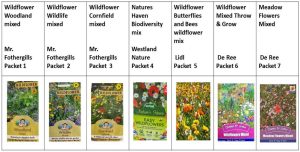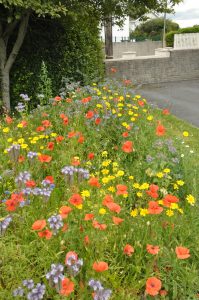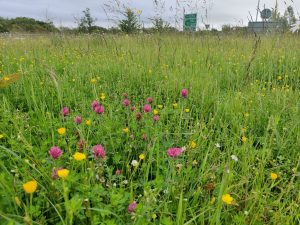By Dr. Noeleen Smyth, University College Dublin
This blog is part of the ‘Dispatches from Researchers’ series, which features guest articles written by experts in pollination and related fields.
We’re all familiar with wildflower seed mixes – colourful, attractive, ‘bee friendly’. You can find them on the shelves of every garden centre and supermarket.
As the biodiversity crisis deepens, many people are turning to these mixes believing they’re the best way to feed hungry pollinators. But a recent study from University College Dublin reveals ‘wildflower’ seed mixes aren’t always what they seem. Dr. Noeleen Smyth tells us more.
Shades of green – “wildflowers” and biodiversity urban planting considerations
This study set out to review the contents of some seed packets for sale in large retail stores in Dublin. Seven of the most common wildflower seed mixes were selected for investigation from four of the largest retail outlets. Seed packets were selected if they specifically mentioned “wildflower” “meadow” or “biodiversity”.

I identified species pictured on the front of the packets or listed on the back. Each species was checked against our known Irish, British and European wildflowers.
Of the 56 species listed on the packets, only 14 (25%) were native to Ireland, however none of the packets gave any information about where the seeds were sourced, so it’s unknown how many if any were of Irish provenance. 44 species (78.5%) were native to Europe, and 12 (21.4%) were species which are not found in Europe but are from Asia, Africa, Mexico, and the USA.
What was in the packets?
Cornflower, Corncockle, Borage, and Pot Marigold were among the most common species in the packets, none of which are considered truly native to Ireland.
Cornflower (Centaurea cyanus) and Corncockle (Agrostemma githago) are generally considered as naturalised former weeds of cereal and flax fields. Borage (Borago officinalis) is native to the Mediterranean, often found as a garden escape on waste ground and rubbish tips.
The most common species to all packets was orange Pot Marigold (Calendula officinalis). This is reputed to be a southern European species, but humans have been cultivating it for so long it’s unknown where if anywhere it still currently exists in the wild.

Native vs. Non-native: Why does it matter?
So why does it matter? Who cares if these flowers are native, or where their seeds come from?
Irish populations of native wildflowers, like Dandelions, Clovers, and Birds-foot trefoil, are the best source of nectar and pollen for our native pollinators. They have evolved alongside each other and are perfectly adapted to give each other what they need.
Non-native species have the potential to negatively affect biodiversity if used in the wrong places, for example by eroding genetic diversity. This is already happening in the case of the Common bluebell, which is now threatened by introduced populations of Spanish bluebell. The two species can hybridise, endangering the genetic integrity of our native bluebell populations.
Crucially, there is shockingly no regulation over the contents of wildflower seed mixes in Ireland or the UK. This means we have no control over what species are in the packets, or where they are sourced.
What’s the solution?
Instead of sowing wildflower seed mixes with uncertain contents, we need to prioritise managing and restoring native meadows.
National grassland surveys revealed 30% of meadows were lost between 2013 and 2019. Smaller areas, like roadside verges and urban greenspace are becoming increasingly important as refuges for our native meadow flowers.
In Dublin, 27% of the city is made up of natural and semi-natural habitats. Grasslands are the largest of these habitats, making up 19%. Almost a third of Dublin city is made up of residential gardens. These spaces have an important future role in supporting biodiversity by providing food and shelter for insects, birds, and mammals. Studies in other cities, like Zurich, have shown that small urban spaces can make a huge difference to native wildflower survival.
We can genuinely help biodiversity in urban areas and truly green our cities by managing and maintaining natural and semi natural grassland habitats. You can find some of the best examples of these habitats in the Great Irish Grasslands Trail.
This change in behaviour might take some adjustment. As humans we are drawn to bright colours as we find higher percentages of bright flowers more attractive, but we are not the ones starving from lack of nectar and pollen – the bees are. The bright ‘wow factor’ of wildflower seed mixes has made them popular, but our Irish meadows have a lower-percentage flower cover and, while not as ’wow’, they are much more important in supporting our native insect, bird, and animal biodiversity.
It’s very tempting to plant what we find attractive rather than doing what our biodiversity needs in this time of crisis. Recent research from Trinity College Dublin compared pollinator visits to planted wildflower seed mixes and local grasslands. The study proved that we really don’t need to spread wildflower seed mixes in our urban landscapes to support bees and pollinators. We just need to let what we have, grow.
If we really want to help biodiversity, we must adopt pollinator-friendly mowing regimes. Native, local wildflowers will pop up naturally if we mow less and remove grass cuttings when we do mow. The All-Ireland Pollinator Plan has advice on how to do this (include links)
Going forward, if we want to be truly ‘green’ in our considerations around urban planting, we must protect the remnants of our native biodiversity now on the fringes of our increasingly urban environments. Spurious species – such as those found in the seed packets in this study – claim to be “wildflowers”, “meadows” or for “biodiversity”. They are none of the above, and have nothing to offer in comparison to the real thing.

Read the full paper here: Shades of green – “wildflowers” and biodiversity urban planting considerations
Dr Noeleen Smyth is an Assistant Professor in Environmental Horticulture at UCD. She is a qualified botanist and chartered horticulturalist with 30 years’ national and international experience in environment, amenity horticulture and conservation botany.
The All-Ireland Pollinator Plan does not endorse any wildflower seed mixes, despite what any third party websites may imply. The best way to grow native wildflowers is by mowing less. See the links below for more information.
Find out more:
Why we don’t recommend wildflower seed mixes
What a meadow should look like
How to create a short-flowering meadow
Creating and restoring meadows in local communities and gardens
